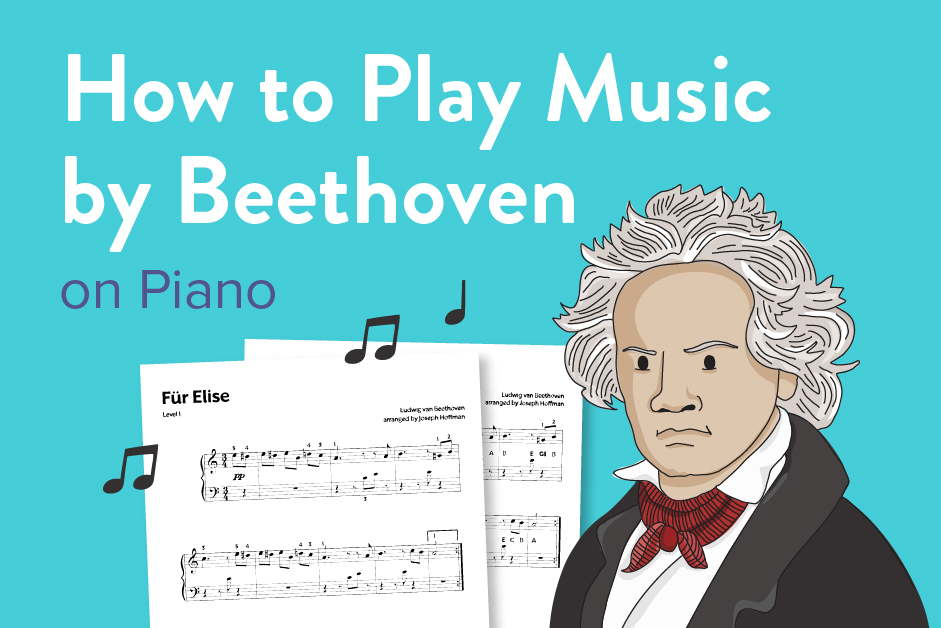Ludwig van Beethoven is one of the most iconic Classical composers of all time. From his infamously moody personality to the ways he changed the direction of music itself, Beethoven has had a tremendous impact on Western music. He is without a doubt a must-know for any music lover. We’ve already talked about Beethoven’s life and personality in our previous post, All About Beethoven. Some of Beethoven’s most famous pieces are for the piano, an instrument that gained immense popularity during his lifetime – but even his orchestral music can be played on the piano as well!
If you want to learn how to play music by Beethoven on the piano, then let us introduce you to some of his most famous works.
How to play music by Beethoven on piano: Ode to Joy
Level: Elementary/Unit 4
Skills: D major pentascale; dotted quarter notes; single-note accompaniment
From concert halls to car commercials, whether played on a harmonica or performed by full orchestra and choir, Ode to Joy is easily THE most recognizable piece by Beethoven. The original song is part of a much larger work: the last movement of Beethoven’s 9th Symphony. It was performed by a full orchestra and large choir, marking the first time a famous composer used voices in a symphony. The lyrics are from a poem by German poet Friedrich Schiller and espouse themes of brotherhood, peace, and humans being free and rational creatures – all very fitting for the political and social movements of the time. Surprisingly, that part of the symphony wasn’t well-received at its premiere, with contemporary composers complaining that the last movement was “very badly set!”
Time has proved those critics wrong. Ode to Joy has not only remained immensely popular, it’s even been used as an anthem for various social and political movements around the world and has been translated into numerous languages. We haven’t included the lyrics in our version, but do check them out – they’re uplifting and powerful no matter what language they’re in!
But enough of the history. Learn to play Beethoven’s Ode to Joy on the piano today and become a part of that history! We have an easy arrangement of Ode to Joy at the end of Unit 4 – truly the best way to celebrate finishing another level of learning. Lesson 78 teaches the melody in the right hand, and Lesson 80 adds a simple accompaniment in the left hand. As with all of our song tutorials, the videos are free and accessible to all. The sheet music for Ode to Joy is included in the Unit 4 materials, which can be bought through our Store – or, for Premium members, downloaded for free!
How to play music by Beethoven on piano: Für Elise
Original level: Intermediate
Skills:
- Main Theme (section A): key of A minor; 3/8 time signature; broken chords/arpeggios; some accidentals; pedal
- Sections B and C: the above, plus ornaments (appoggiaturas, acciaccaturas/grace notes, turns); reading blocked chords; multi-octave arpeggios; chromatic scale
Simplified versions: Elementary, Late Elementary
Skills: key of A minor; 3/4 time; some accidentals
“Für Elise” is not only one of Beethoven’s most popular piano pieces; it is also surrounded by mystery! We’ve already done a deep-dive into the piece in All About “Für Elise”, so check that out if you’re curious.
If you want to learn how to play “Für Elise” on the piano, we have you covered with 3 different versions of the piece. As always, our video lessons are entirely free, and the sheet music can be purchased from our Store – though for Premium members, it’s free to download!
For Early Elementary players (Units 3-4), try the Preparatory Level “Für Elise.” This version uses both hands to play the melody, so there’s no awkward stretching or reaching involved. Our Level 1 version of “Für Elise” picks up where the Preparatory version leaves off, completing the main melody.
Want to learn the original main theme of “Für Elise?” It’s actually not that hard for an Early Intermediate level student (Units 13+), and on its own makes a beautiful piece. And, if you’re up for a real challenge, try the “B” and “C” sections as well! They’re a bit more advanced, but once again, Mr. Hoffman can be your guide in our video tutorials.
Here are all of the video tutorials for how to play “Fur Elise” on the Piano:
- Fur Elise – Prep
- Fur Elise – Level 1
- Fur Elise – Main Theme
- Fur Elise – B Section
- Fur Elise – C Section
How to play music by Beethoven on piano: Moonlight Sonata
Original level: Advanced
Skills: Key of C-sharp minor (4-sharp key signature); hand span of an octave or more; broken chords; accidentals; pedaling
Simplified version: Intermediate (Units 13+)
Skills: key of D minor (1 flat key signature); broken chords; hand span of 6th; some accidentals; pedaling
Just as literature has different forms, like novels, vignettes, short stories, and poems, music has various forms as well. One of those forms is the sonata. Most sonatas have more than one “movement,” which can be thought of as chapters in a book, or courses in a fancy meal. Each course can be enjoyed on its own, but they’re meant to be consumed as a sequence. Many sonatas have three movements, usually starting with a fast movement, followed by a slower middle movement, then ending with another fast movement. Sonatas as we tend to know them today became popular in the Classical Era of music (around 1750-1820), and were a favorite form of composers like Mozart and Beethoven.
Beethoven wrote just 32 piano sonatas, a relatively small number if you look at some of his predecessors. He believed in quality over quantity and made each of his works unique and recognizable. One of his most well-known piano sonatas is the Sonata Opus 27, Number 2, nicknamed the “Moonlight Sonata.” That moniker was actually not given by Beethoven himself! As the story goes, years after its publication, a poet by the name of Ludwig Rellstab compared the sound of the atmospheric first movement to moonlight shining on a lake. The name stuck, and this piece has been known as the “Moonlight Sonata” ever since.
The part of the Moonlight Sonata that most people are familiar with is the first movement. Dark, pensive, and haunting, it showcases how expressive one can be with nothing more than broken chords and a scant, rhythmic melody. The original piece for piano is around the Early Advanced level in terms of difficulty; if you’re interested in trying it out, you can find free, public domain versions of it on the Internet Music Score Library Project, or IMSLP.
We’ve also simplified it for Early Intermediate players to enjoy! Check out the free video tutorial (linked below) and buy the sheet music in our store. For Premium members, the sheet music is free to download!
How to play music by Beethoven on piano: Sonatina in G Major
Level: Intermediate/Unit 15
Skills:
- 1st movement: 4/4 time signature; key of G major (1 sharp); acciaccaturas/grace notes; Alberti bass/broken chords; 1-octave scales
- 2nd movement: 6/8 time signature; key of G major; broken chords; acciaccaturas/grace notes; slurs and staccato; rolled chords; appoggiatura; hand span of a 7th (can be modified)
“Sonatina” simply means “little sonata.” Sonatinas are usually shorter in length and easier in difficulty than sonatas, though they follow the same basic form. Beethoven’s Sonatina in G major is a wonderful way to break into learning piano music written by Beethoven! No simplifying or arranging here: you’ll learn the original two movements of the Sonatina in G major as Beethoven wrote them. With Mr. Hoffman’s guidance, you’ll not only learn the notes, but also the artistry and form of the sonatina, just as you would with any live piano teacher.
We’ve broken the piece down into a few tutorials in Unit 15, so you can learn the piece one step at a time at your own pace. Sheet music for the sonatina is included in the Unit 15 materials, which you can buy in the store or download for free as a Premium member.
- Lesson 281: Sonatina in G: First Movement: Right Hand
- Lesson 282: Sonatina in G: First Movement: Left Hand
- Lesson 283: Sonatina in G: First Movement: Form & Artistry
- Lesson 285: Sonatina in G: Second Movement: Right Hand
- Lesson 286: Sonatina in G: Second Movement: Left Hand
- Lesson 287: Sonatina in G: Second Movement: Form & Artistry
How to play music by Beethoven on piano: Sonatina in F Major, 1st Movement
Level: Intermediate/Unit 16
Skills: 2/4 time signature; key of F major; 16th notes; scales; broken chords; acciaccaturas/grace notes; slurs, staccato, and tenuto marks; accidentals; changing clefs; wide variety of dynamics; modulation
Beethoven’s Sonatina in F major is a milestone piece for intermediate piano students! Another 2-movement sonatina, it’s longer and more challenging than its G major cousin, with a wide variety of techniques and moods. It’s truly a “little” sonata, only separated from the full form by its shorter length. This is a great piece to stretch your expressive muscles and imagination!
Once again, we’ve broken down Beethoven’s Sonatina in F major to help you learn the notes, technique, and artistry involved.
- Lesson 319: Sonatina in F, 1st Movement: A Section
- Lesson 320: Sonatina in F, 1st Movement: B Section
- Lesson 321: Sonatina in F, 1st Movement: Final Section
- Lesson 322: Sonatina in F, 1st Movement: Form & Artistry
We hope you enjoy learning these incredible piano pieces by one of the greatest musicians of all time!




